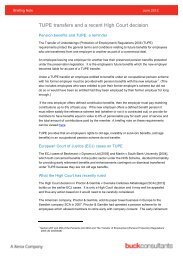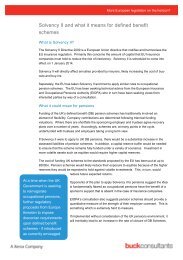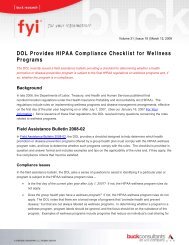Can your long-term incentive plan become more performance based ...
Can your long-term incentive plan become more performance based ...
Can your long-term incentive plan become more performance based ...
You also want an ePaper? Increase the reach of your titles
YUMPU automatically turns print PDFs into web optimized ePapers that Google loves.
[ searching for answers ]<br />
insightout<br />
tm<br />
From Buck Consultants<br />
Thought Leaders<br />
<strong>Can</strong> Your Long-Term Incentive Plan Become More<br />
Performance Based Again?<br />
By Larry Schumer<br />
Atop responsibility for Compensation Committees is to ensure a strong linkage between executive<br />
compensation and company <strong>performance</strong>. Long-Term Incentive Plans (LTIPs) typically provide the<br />
largest component of senior executives’ compensation, most often through one or <strong>more</strong> of three equity<strong>based</strong><br />
types: Stock Options, Restricted Stock, and Performance Shares.<br />
This InsightOut assesses the relative strength of the linkages<br />
between company <strong>performance</strong> and each type of equity when<br />
included in an LTIP. It also:<br />
<br />
<br />
<br />
Makes the case for increasing usage of Performance Shares<br />
as a key component of LTIPs<br />
Provides data supporting the conclusion that this increase<br />
is, in fact, occurring; Buck Consultants’ data focuses on<br />
practices in mid-size to large companies, those between<br />
$500 million and $5 billion in revenue<br />
Poses key design questions for Compensation Committees<br />
who are considering Performance Shares in their LTIPs<br />
Scoring Equity-Based LTIPs from a<br />
Performance Perspective<br />
Buck believes that these three types of LTIPs incorporate the<br />
concept of <strong>performance</strong> to very different degrees.<br />
Let’s start with Stock Options. Options have earned a mixed<br />
reputation in the marketplace for various reasons, including:<br />
<br />
<br />
<br />
The multi-million-dollar gains executives received from<br />
exercising options granted over many years of a strong<br />
economy and bull market when a company’s actual<br />
<strong>performance</strong>, although decent, could have — and, perhaps,<br />
should have — been stellar<br />
The backdating scandal<br />
The end of “no-cost options” brought about by FAS 123R<br />
These factors prompted a move away from a predominance of<br />
Stock Options in LTIPs during the 1990s and in the early years<br />
of this decade to the much greater use of Restricted Stock in<br />
the last three to five years. However, we would still give Stock<br />
Options a “<strong>performance</strong> score” of B or B+ because they are an<br />
“appreciation-only vehicle.” When granted, they have no<br />
intrinsic value and may never have value unless a company’s<br />
financial <strong>performance</strong> raises its stock price.<br />
We give Restricted Stock a low <strong>performance</strong> score of D because,<br />
as a time-<strong>based</strong> award, it rewards executives “for just sticking<br />
around.” Even a stock price that drops 20 percent over the<br />
vesting period still provides 80 percent of the value for what<br />
was likely poor <strong>performance</strong>. However, if companies were to<br />
use only cliff vesting of restricted stock after three or four<br />
years, and Boards were to <strong>become</strong> <strong>more</strong> diligent about<br />
replacing lower performing CEOs and other senior executives,<br />
then we would increase the score from a D to a C+ or B-.<br />
Clearly, there are reasons why the move from Stock Options to<br />
Restricted Stock that took place from 2002 through 2007 was<br />
a rational move. For one thing, a declining or flat stock market<br />
during some of those years made these full-value grants even<br />
<strong>more</strong> appealing to executives. The move also reduced dilution,<br />
which shareholders saw as a positive outcome. And, of course,<br />
the “great equalizer” of FAS 123R, which requires all equity<br />
programs to have a cost recognized through the income<br />
statement, was a major factor. However, we do believe that the<br />
pendulum had swung very far as many companies moved<br />
mostly or totally to Restricted Stock grants.
Of the three types, Performance Shares provide the strongest<br />
link to <strong>performance</strong>. They have been prevalent in the largest,<br />
<strong>more</strong> mature companies for many years. In recent years, they<br />
also have been appearing increasingly in the equity mix of<br />
LTIPs for mid-size companies. We give them a <strong>performance</strong><br />
score of A because shares are earned only for attainment of<br />
specific financial goals set by the Board or Compensation<br />
Committee.<br />
The most common Performance Share <strong>plan</strong> would be one that<br />
sets a target number of shares — let’s use an example of<br />
10,000 shares — that a CEO could earn for <strong>performance</strong> over a<br />
three-year period. This sample <strong>plan</strong> could have two metrics,<br />
each equally weighted and each with a specific target —<br />
Return on Equity (ROE) over three years targeted at 12 percent<br />
and Total Shareholder Return (TSR) over three years against a<br />
peer group at the 55th percentile. Chart One presents a<br />
complete example of how the formula would work given<br />
various outcomes under the two metrics. For instance, the CEO<br />
might earn no shares if the ROE were less than nine percent or<br />
120 percent of the 5,000-share target if ROE were 14 percent.<br />
The Data Trail Leads to More<br />
Performance Shares in LTIPs<br />
Recent data points to a strong trend toward greater use of<br />
<strong>performance</strong>-<strong>based</strong> equity <strong>plan</strong>s in the form of Performance<br />
Shares. Let’s look at company practices in 2006 and 2007 from<br />
three data sources.<br />
First, Buck’s client projects in 2007 often included a proxy<br />
analysis of the client’s peer companies, looking at data mostly<br />
from 2006. In several different projects, in industries as diverse<br />
as technology and utilities, we saw Performance Share<br />
programs in 15 percent to 20 percent of the mid-size to large<br />
companies we looked at with revenues of $500 million to<br />
$5 billion.<br />
Second, Buck’s annual Global Long-Term Incentive Survey<br />
provides data on executive and non-executive <strong>incentive</strong><br />
programs in 35 countries. The 2007 survey, <strong>based</strong> on data as of<br />
April 2007, found that just <strong>more</strong> than 30 percent of all<br />
respondents maintained such <strong>incentive</strong> programs. (The large<br />
majority of these 30 percent of companies used Performance<br />
Shares, but a few used options with <strong>performance</strong> conditions for<br />
vesting.) Interestingly, this is double the approximately<br />
15 percent prevalence we found from our 2004 survey.<br />
Chart One<br />
Value<br />
(Percent)<br />
ROE<br />
Percentage<br />
of Target<br />
Shares<br />
Earned<br />
Third, to obtain as current a sample as possible, we analyzed<br />
40 companies in our targeted range ($500 million to $5 billion<br />
in revenues) across industries with fiscal years ending<br />
September 30, 2007. These companies will have just filed their<br />
proxy statements in the first three months of 2008. Among<br />
these 40 companies, 35 percent used <strong>performance</strong> equity<br />
<strong>plan</strong>s. Chart Two on page 3 also highlights the types of equity<br />
chosen by the 16 companies that used only one type and the<br />
13 companies that used two types.<br />
Recent data points to a strong trend<br />
toward greater use of <strong>performance</strong><strong>based</strong><br />
equity <strong>plan</strong>s in the form of<br />
Performance Shares.<br />
Value<br />
(Percentile<br />
against Peer<br />
Group)<br />
Less than 9% 0% Below 45th<br />
percentile<br />
Between 9%<br />
and 9.99%<br />
Between 10%<br />
and 11.99%<br />
Between 12%<br />
and 12.99%<br />
Between 13%<br />
and 14.99%<br />
15% and<br />
higher<br />
50% Between 45th<br />
and 49th<br />
percentile<br />
80% Between 50th<br />
and 54th<br />
percentile<br />
100% Between 55th<br />
and 59th<br />
percentile<br />
120% Between 60th<br />
and 69th<br />
percentile<br />
150% 70th<br />
percentile and<br />
higher<br />
TSR<br />
Percentage<br />
of Target<br />
Shares<br />
Earned<br />
0%<br />
50%<br />
80%<br />
100%<br />
120%<br />
150%<br />
2 insightout
Chart Two<br />
Clearly, these three data sources indicate a strong trend toward<br />
greater use of <strong>performance</strong>-<strong>based</strong> equity programs among<br />
mid-sized companies. We expect the prevalence of such<br />
programs to increase to well over 50 percent in the next two to<br />
three years.<br />
Considering Performance Shares?<br />
If So, Consider This<br />
Although a detailed discussion of Performance Share <strong>plan</strong><br />
design is beyond this article’s scope, those contemplating such<br />
a <strong>plan</strong> should consider the following key issues:<br />
<br />
<br />
Number of LTIP Types<br />
in the Plan None One Two Three<br />
Percentage of the 40<br />
Companies<br />
Number of the 40<br />
Companies Using<br />
One Type<br />
13% 40% 32% 15%<br />
16 Number of the 40<br />
Companies Using<br />
Two Types<br />
Stock Options only 8 Stock Options and<br />
Restricted Stock<br />
Restricted Stock<br />
only<br />
Performance Shares<br />
only<br />
5 Stock Options and<br />
Performance Shares<br />
3 Restricted Stock and<br />
Performance Shares<br />
How many metrics should be used? We suggest using only<br />
one or two so as not to diminish the importance of any<br />
metric used. The number of metrics used should be<br />
influenced by how large a percentage of the total LTIP<br />
opportunity is to come from Performance Shares.<br />
Which metrics should be chosen? The best course is to<br />
choose metric(s) that align most closely with the business<br />
strategy and stakeholder expectations. (Note that<br />
different types of metrics can result in different<br />
accounting treatment under FAS 123R.)<br />
13<br />
6<br />
3<br />
4<br />
<br />
<br />
<br />
Should the company’s <strong>performance</strong> under the <strong>plan</strong> be<br />
compared at the end of the <strong>performance</strong> period to a peer<br />
group’s and/or the company’s own <strong>performance</strong>? There is<br />
no right or wrong answer here. The basis for comparison<br />
should be established after an active dialogue between the<br />
Compensation Committee and CEO. If two metrics are used,<br />
we generally suggest a mix of comparisons — one relative<br />
to a peer group and the other company-specific —<br />
especially in the early years.<br />
At what levels should the targets, threshold, and<br />
maximum <strong>performance</strong> levels be set? Generally, we<br />
recommend steep grading lines (for instance, the relatively<br />
large increments between the target shares set in Chart<br />
One) to keep the <strong>performance</strong> intention strong. We know<br />
that fewer or <strong>more</strong> shares will be awarded <strong>based</strong> on<br />
<strong>performance</strong>, but it is also important to remember the selfadjusting<br />
nature of the value of Performance Shares. To<br />
the extent the <strong>performance</strong> measures are those underlying<br />
shareholder value creation, then <strong>performance</strong> below target<br />
would result in fewer lower-priced shares and <strong>performance</strong><br />
above target would result in <strong>more</strong> higher-priced shares.<br />
How <strong>long</strong> should the <strong>performance</strong> period be? If these are<br />
<strong>long</strong>-<strong>term</strong> <strong>plan</strong>s, shouldn’t the <strong>performance</strong> period be<br />
three years? In response to this observation, we hear CEOs<br />
saying that it is too difficult to set the achievable goals for<br />
a multi-year period because their businesses change too<br />
frequently. However, Compensation Committees need to<br />
push back on this argument because many of these<br />
executives are eligible to receive overlapping grants<br />
annually from the LTIP. Therefore, even if the company’s<br />
<strong>performance</strong> does not merit a grant payout to executives<br />
for one period, opportunities still exist for payouts from<br />
subsequent, overlapping grants. To address this point,<br />
Compensation Committees may want to propose:<br />
– Phasing into a three-year period by first using a<br />
two-year period<br />
– A hybrid arrangement composed of a two-year, or even<br />
one-year, <strong>performance</strong> period followed by additional<br />
years of vesting to maintain the “<strong>long</strong>-<strong>term</strong> feel”<br />
insightout 3
What is the “appropriate” mix of equity types in an LTIP?<br />
Companies often use a combination of Stock Options,<br />
Restricted Stock, Performance Shares, and multi-year cash<br />
<strong>plan</strong>s, especially in the early years of experimenting with a<br />
new type of <strong>plan</strong>. We suggest limiting the combination to<br />
two types, including Performance Shares. Also,<br />
Compensation Committees sometimes choose to start with<br />
Performance Shares making up less than half of the total<br />
<strong>incentive</strong> opportunity and then increasing that proportion<br />
over time.<br />
As Compensation Committees consider the design issues<br />
surrounding their LTIPs, they must do something of a balancing<br />
act. On the one hand, they must represent the interests of<br />
shareholders, whose natural preference would be for the <strong>more</strong><br />
rigorous and <strong>more</strong> <strong>performance</strong>-<strong>based</strong> behavior that<br />
Performance Shares promote. On the other hand, Compensation<br />
Committee members also know that shareholder interests<br />
include the retention and motivation of senior executives.<br />
These same executives often place a higher value on Restricted<br />
Stock, which has only time-<strong>based</strong> restrictions on receiving the<br />
value. Restricted Stock is often referred to as having “retentive<br />
value” and this can be interpreted to mean that it is better for<br />
or <strong>more</strong> valued by the recipient.<br />
Conclusion<br />
The link between pay and <strong>performance</strong> is paramount in<br />
executive compensation <strong>plan</strong>s. Compensation Committees are<br />
doing a better job of forging this link, as evidenced by the<br />
increasing use of Performance Shares and other <strong>performance</strong><strong>based</strong><br />
LTIPs. Almost all Compensation Committees are at least<br />
discussing these issues. We are still in the early stages of this<br />
movement, but it is happening quickly. As it progresses, it will<br />
be interesting to see how <strong>performance</strong> <strong>plan</strong>s evolve and<br />
whether they grow to be the dominant component of total LTIP<br />
opportunities for top executives.<br />
About the Author:<br />
Larry Schumer, a Boston-<strong>based</strong> principal in Buck’s<br />
Compensation practice, has 15 years of executive compensation<br />
consulting experience. Larry has also served as head of Human<br />
Resources at a technology industry company and a services<br />
industry company, each with <strong>more</strong> than 10,000 employees.<br />
He can be reached at 617.275.8048 or at<br />
larry.schumer@buckconsultants.com.<br />
As Compensation Committees<br />
consider the design issues<br />
surrounding their LTIPs, they must<br />
do something of a balancing act.<br />
© 2008 Buck Consultants, LLC. All rights reserved.<br />
Insight® is a registered trademark and InsightOut tm is a trademark of Buck Consultants, LLC.















